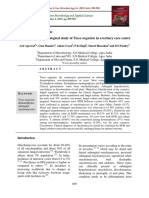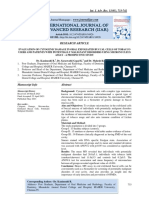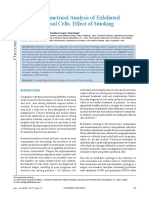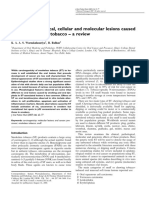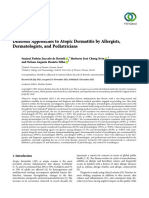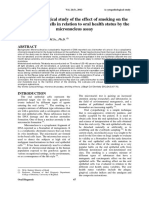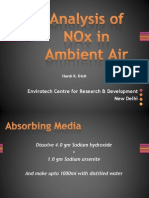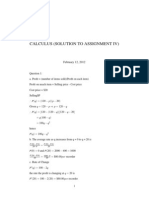Professional Documents
Culture Documents
A Clinicopathological Evaluation of Oral Mucosal Lesions in Patients With Smokeless Tobacco Addiction at Tertiary Health Care Center
Copyright
Available Formats
Share this document
Did you find this document useful?
Is this content inappropriate?
Report this DocumentCopyright:
Available Formats
A Clinicopathological Evaluation of Oral Mucosal Lesions in Patients With Smokeless Tobacco Addiction at Tertiary Health Care Center
Copyright:
Available Formats
Volume 11, Issue 3, March 2023 International Journal of Innovative Science and Research Technology
ISSN No:-2456-2165
A Clinicopathological Evaluation of Oral Mucosal
Lesions in Patients with Smokeless Tobacco
Addiction at Tertiary Health Care Center
Dr. Reena Vare Dr. Nidhi Desai
Professor and Head of Department of E.N.T, Resident of Department of E.N.T,
MGM College and Hospital, Aurangabad, Maharastra MGM College and Hospital, Aurangabad, Maharastra
Abstract:- The various smokeless tobacco habits Oral lesions usually manifest clinically as one of the
practiced throughout the world include tobacco following: change in colour and contour, swelling, ulcers,
chewing and snuff dipping. Smokeless tobacco products ulcero-proliferative , vesiculo-bullous or surface textural
have been linked to precancerous and cancers of oral changes and at the histological level –inflammation,
cavity for long. The aim of the present study was to vacuolization, epithelial atrophy, acanthosis,
record various mucosal lesions associated with hyperkeratosis/hyperparakeratosis. The principle changes
smokeless tobacco usage and to ascertain the prevalence seen in the oral cavity related to Smokeless tobacco use
of dysplasia in them by histopathological evaluation and include oral mucosal lesions (OMLs) typically defined as
to see the extent of disease seen among patients SLT-induced keratoses (STKs) & Tobacco pouch keratosis,
associated with a habit of smokeless form of tobacco. recurrent aphthous ulcers, oral submucosal fibrosis,
leukoplakia and proliferative verrucous leukoplakia,
MATERIALS AND METHODS: 112 patients with the erythroplakia, oral lichen planus, dysplasia and oral
clinical diagnosis of smokeless tobacco related lesions cancer.3 In India, use of tobacco is very common and
were selected. A detailed description of the clinical culturally acceptable among both the genders. The
presentation of the lesion was noted and the patients large‐scale morbidity and mortality caused by oral cavity
were subjected to incisional biopsy followed by a cancers is largely preventable. Screening of oral cavity
histopathological evaluation. results in detection of precancerous lesions which may
further progress in due course of time to invasive oral
RESULTS: 38 (33.93%) of the patients were confirmed cancers. There is an urgent need to assess the efficacy and
cases of Carcinoma followed by 23 (20.54%) with effectiveness of oral cancer prevention and screening in
OSMF and 20 (17.86%) with aphthous ulcers. Rest of general and high‐risk population.
the final diagnosis were distributed wide. We found that
buccal mucosa was the most commonest site of lesion II. AIMS AND OBJECTIVES
with the incidence of about 37.5% followed by tongue
among 20.54%. Pre-malignant lesions was found among The aim is to evaluate clinicopathology of oral
74 (66.07%) patients included in our study where as 38 mucosal lesions in smokeless tobacco addiction coming to
(33.93%) patients found with maliganant lesions. tertiary health care center. Objectives are to study the
pattern and presentation of different types of premalignant
CONCLUSION: Thus, the study highlights the role of and malignant lesions among various subgroups of
detecting oral mucosal lesions and screening high-risk smokeless tobacco users, also to know the malignant
patients on a regular basis and also reaffirms the transformation as a multistep process that should be
importance of public education, stressing the risk approached from the clinicopathological standpoint and to
factors for oral cancers. Promote healthy oral hygiene and regular screening in
asymptomatic smokeless tobacco users.
Keywords:- SMOKELESS TOBACCO, ORAL MUCOSAL
LESIONS, PREMALIGNANT LESION, ORAL III. MATERIALS AND METHOD
CARCINOMA
It is 2 year study was conducted in the ENT
I. INTRODUCTION department of MGM hospital, a tertiary care referral center.
Patients presenting to the outpatient department with oral
For hundreds of years, tobacco has been smoked, mucosal lesions with addiction of amokeless tobacco were
chewed, and inhaled in various Forms.1 Smokeless tobacco included in the study. A detailed clinical workup including
(SLT) is a broad encompassing term that includes both personal history and habits were done. Patients were
chewing tobacco and snuff. Three types of Smokeless observed for resolution of the lesions; those which
tobacco are commonly manufactured: loose-leaf chewing persisted despite treatment were biopsied to diagnose the
tobacco, moist snuff, and dry snuff. 2 Smokeless tobacco underlying pathology. Patients were counseled about the
usage is influenced by various factors such as individual potential of malignancy and advised complete abstinence
attitude, stress, workload, availability, advertising from tobacco. Photo‑documentation of the lesions was
campaigns, etc. In case of mucosal lesions in the oral done.
cavity, even the finest radiological examination contributes
little, when compared to direct visualization techniques.
IJISRT23MAR818 www.ijisrt.com 871
Volume 11, Issue 3, March 2023 International Journal of Innovative Science and Research Technology
ISSN No:-2456-2165
After satisfying criteria total 112 number of patients In the total sample of 112 lesions, 38 (33.93%) were
were enrolled in this study for 2 years starting from oral carcinoma (fig 1), 23 (20.54%) were oral submucous
December 2020 to December 2022. Both male and female fibrosis (fig 2 and 3), 15 (13.39%) were aphthous ulcer, 10
genders above age of 16 years were included in study. (8.93%) were leukoplakia (fig 4), 10 (8.93%) were
After the approval of Institutional ethical committee smokeless keratosis (fig 5), 9 (8.04% ) were melanoplakia,
approval, an informed written consent from the patients 3 (2.68%) were erythroplakia (fig 6), 2 (1.79%) were
were attained before taking up the study. The selected gingivitis and 2 (1.79%) were glossitis. (graph 1)
patients were questioned regarding their tobacco related
habits which included the type, frequency and duration of Of the 112 lesions, 42 (37.5%) were located on the
tobacco usage. This was followed by recording case history buccal mucosa and 23 (20.54%) on the tongue. The other
and a detailed description of the clinical presentation of the sites affected in the decreasing order of frequency were
lesion. The predesigned Performa was used to record the faucial pillar 17 (15.18%), retromolar trigone 9 (8.04%),
data. The standardized performa included patient’s palate 8 (7.14%), labial mucosa 8 (7.14%) and gingival 5
demographic details such as age, sex, educational status, cases with a percentage of 4.45%. (graph 2) Oral
occupational details and types of habit and frequency of carcinoma showed the highest occurrence in the buccal
habit. Further habit associated mucosal lesions were mucosa which shows more site prediliction (p < 0.001).
recorded. Once a suspicious lesion was found, further Leukoplakia occurred predominantly in the buccal mucosa
examination i.e. Biopsy was conducted under local and commissural areas.
anaesthesia. The collected data was entered in spread sheet.
In the smokeless tobacco, the most common habit of
IV. RESULTS consumption associated with the lesions was the use of
betel quid with tobacco by chewing in 97 cases, dipping
The present study was done to record various mucosal with spitting in 35 cases and 15 cases were of local
lesions associated with smokeless tobacco usage in relation application.
to age, sex, duration and frequency of habit and to evaluate
their histopathologic findings. In the total sample size of Out of the total size, 59 lesions (52.68%) occurred
one hundred twelve(112) patients, 81 (72.32%) were males within 10 years duration of habit; 31 lesions (27.68%)
and 31 (27.68%) were females with a mean age group of between 11 and 20 years while the remaining 22 lesions
41-60 years. Co-morbidities were seen associated more in (19.64%) occurred with the habit duration greater than 20
males (96%) than in females (4%). Oral submucous fibrosis years. 62 lesions (55.36%) occurred with a frequency of 1
was 24.11 times significantly more in males compared to to 5 times of tobacco usage per day, 36 lesions (32.14%)
females with p < 0.001. occurred with the frequency ranging between 6 and 10
times per day and another 14 lesions (12.50%) with a
frequency greater than 10 times per day.
Fig. 1: growth on left retromolar trigone Fig. 2: oral submucous fibrosis
IJISRT23MAR818 www.ijisrt.com 872
Volume 11, Issue 3, March 2023 International Journal of Innovative Science and Research Technology
ISSN No:-2456-2165
Fig. 3: fibrotic bands in oral cavity Fig. 4: leukoplakia in right sided buccal mucosa
Fig. 5: Smokless keratosis Fig. 6: Erythroplakia on right buccal mucosa
V. DISCUSSION patients were aged between 15 to 24 years (255/829),
followed by 25 to 34 years and 35 to 44.7 Another similar
As per the Global Adult Tobacco Survey conducted in study by Ramani VK et al had reported that the average age
the year 2009, almost 35% of adults in India are using of their patients was 54.9±12.5 years. The higher incidence
tobacco in different forms.4 Of these, 47.9% are males and of study samples in Ramasamy J et al were in 4th decade in
20.3% females. The average age at initiation was found to group A. Those in Group B and C were in their 6th
be 17.9 years. Nearly one-third, about 29.9% of adults were decade.8,9 where A: only chewing tobacco, Group B: Only
exposed to second-hand smoke at the workplace, 52.3% at smoking and Group C: Both chewing and smoking.
home and 29% at other public places. 5,6 Smokeless
tobacco (SLT) is available in many forms in India which has Out of 112 study population, there were 81 (72.32%)
been widely used by all the social groups, including women, and 31 (27.68%) males and females. Yuvaraj BY et al had
especially in rural areas. There is a wide spectrum of conducted the similar study but among the woman
morbidity and mortality related to SLT use, both among population only. Whereas in Ramani VK et al, 94% of them
men and women. Hence, the present study was conducted to were males and only 6% females observed among the study
evaluate the clinicopathology of oral submucosal lesions in population. Ramasamy J et al had found that 88.8% of their
patients with smokeless tobacco addiction presenting to study population being males and 11.2% of them were
tertiary care hospital and to analyse the risk pattern, female. Group B and C had only male patients.7-9
distribution of lesions and their presentation.
50 (44.64%) had presented with difficulty swallowing
In the present study, we observed that the incidence of or mouth opening followed by 19 (16.96%) with ulcers. 15
study population aged between 41 to 60 years was higher, (13.39%) had developed the swelling and 9 (8.04%)
accounted for about 55 (49.11%) followed by 29 (25.89%). complained of growth. 7 (6.25%) each had observed to be
22 (19.64%) were aged between 61 to 80 years, 5 (4.46%) pain and lesions in the mouth. 1 (0.89%) each had bad
aged </=20 years and the rest one patient was aged more breath, scarring and deviation of the tongue.
than 80 years. Similarly, in Yuvaraj BY et al, majority of the
IJISRT23MAR818 www.ijisrt.com 873
Volume 11, Issue 3, March 2023 International Journal of Innovative Science and Research Technology
ISSN No:-2456-2165
SITE OF LESION
5%
7%
BUCCAL MUCOSA
TONGUE
39%
16% PALATE
RMT
FAUCIAL PILLARS
8%
LABIAL MUCOSA
7% GINGIVA
18%
Fig. 7: Site of Lesion
Muthukrishnan A et al explains that Lateral margins had developed over faucial pillars. 9 patients at RMT, 8
of tongue and floor of mouth are the high-risk sites due to each in mouth and palate, 5 patients in GBS . Whereas in
pooling to tobacco fluid in this horse-shaped area of the Ramasamy J et al., Group A patients: OSMF and chewer's
mouth. In later stages, the limitation of mouth opening, mucositis were found to be more compared to other lesions.
rigidity of tongue and metastasis to lymph nodes are Male patients had a higher incidence of lesions than
comparatively common. Buccal carcinoma with extraoral females. 55 patients were presented with OSMF. Tobacco
fungation are also expected lesions.10 pouch keratosis was seen among 7 individuals, Lichenoid
reaction was seen among 7 patients, OSCC was seen among
Based on the data obtained, we observed that 42 6 individuals, Lichen planus and candidiasis were found
(37.5%) of the patients had developed lesions over buccal among one patient, respectively.8
mucosa followed by 23 (20.54%) over tongue. 17 (15.18%)
CLINICAL FINDINGS
40
35
30
25
Axis Title
20
15
10
5
0
ORAL OSMF LEUK APHT SMOK ERYT MELA GINGI GLOSS
CA OPLA HOUS ELESS HROPL NOPL VITIS ITIS
KIA ULCER KERA AKIA AKIA
S TOSIS
cases 38 23 10 15 10 3 9 2 2
percentage 33.93 20.54 8.93 13.39 8.93 2.68 8.04 1.79 1.79
Fig. 8: Clinical Findings
IJISRT23MAR818 www.ijisrt.com 874
Volume 11, Issue 3, March 2023 International Journal of Innovative Science and Research Technology
ISSN No:-2456-2165
Among the patients in Group B, smoker's palate in 17 incidence of oral mucosal lesions being carcinomatous,
and smoker's melanosis in were found to be the most among the patients with habits of SLT is not negligible,
predominant lesions evident among this group, followed by hence, screening all the patients with habitual history of
leukoplakia and combined lesion of leukoplakia with SLT consumption is must in order to determine the type of
smoker's melanosis among 6 each were seen. Central lesion as well as early treatment among them.
papillary atrophy of the tongue, candidiasis and leukoedema
were also seen with lesser incidence. Among the mixed REFERENCES
habit which was designated as C Group in their study,
OSMF was found among 10 patients and it was the higher [1.] Christen AG, Swanson BZ, Glover ED, et al.
incidence and other individual lesion like smoker's Smokeless tobacco: the folklore and social history of
melanosis among 6, carcinoma 5, leukoplakia in 4 patients, snuffing, sneezing, dipping and chewing. J Am Dent
tobacco pouch keratosis and lichen planus were also seen in Assoc 1982; 105(5):821–9.
one each. Combined lesions like smoker's melanosis with [2.] Wahlberg I, Ringberger T. Smokeless tobacco. In:
leukoplakia, OSMF with leukoplakia, smoker's melanosis Davis DL, Nielsen MT, editors. Tobacco: production,
and leukoplakia along with OSMF, smoker's melanosis with chemistry and technology. Oxford (United Kingdom):
OSMF were also seen.8 Blackwell Science; 1999. p. 452–60.
[3.] Robert O. Greer Jr, DDS, ScDa,b,c,*. oral
Binmadi N et al who had aimed at similar outcome manifestations of smokeless tobacco use p.32
found that SLT lesions in theoral cavity were usually focal [4.] 27. Global adult tobacco survey. Second round.
lesions, accounting for about 76.3%. The most preferred INDIA 2016-17: REPORT. Available on
placement site by SLT users was themandibular posterior https://main.mohfw.gov.in/sites/default/files/Globalto
vestibule. 11 bacoJune2018_0.pdf. Accessed on 12th Dec 2022
[5.] Yuvaraj BY, Mane VP, Anilkumar L, Biradar M,
Of all the clinical diagnosis, carcinoma was the Nayaka V, Sreenivasamurthy R. Prevalence of
frequent finding among 38 (33.93%) patients included in our Consumption of Smokeless Tobacco Products and
study followed by 23 (20.54%) with fibrosis. 13 each were Exposure to Second-Hand Smoke among Women in
diagnosed with inflammation and ulcers, 10 patients had the Reproductive Age Group in a Rural Area of
smokeless keratosis, 10 patients with leukoplakia and 9 with Koppal, Karnataka. Indian J Community Med. 2020
melanoplakia. 15 patients were found to be having aphthous Jan-Mar;45(1):92-95.
ulcers and 3 patients had erythroplakia. Straif et al while [6.] Smokeless Tobacco and Public Health in India. [Last
analysing the pathophysiology of oral lesions due to SLT, accessed on 2022 Dec 26]. Available
verified with the evidences that SLT components could from: http://www.searo.who.int/india/tobacco/smokel
affect human epithelial cells and fibroblasts by increasing ess_tobacco_and_public_health_in_india.pdf?ua=1 . [
the production of reactive oxygen species, cell turnover, Ref list]
collagen synthesis, and gingival blood flow or DNA [7.] Ramasamy J, Sivapathasundharam B. A study on oral
damage, which causes oral mucosal changes and may mucosal changes among tobacco users. J Oral
progress to SCC. Hence, the observed lesions in this present Maxillofac Pathol 2021;25:470-7
clinical trial.12 [8.] Yuvaraj B. Y, Mane VP, Biradar AL, Nayaka M,
Sreenivasamurthy V, Rashmi. Prevalence of
With the above discussion we could observe that the Consumption of Smokeless Tobacco Products and
oral lesions have wide clinical and morphological variation. Exposure to Second-Hand Smoke among Women in
Hence, the present study has been one of the reliable the Reproductive Age Group in a Rural Area of
evidence for the clinical as well as morphological Koppal, Karnataka. Indian Journal of Community
presentation of oral lesions among the patients with Medicine. Jan–Mar 2020; 45(1):p 92-95.
smokeless tobacco consumption at our epidemiological area. [9.] Ramani VK, Benny N, Naik R. Characteristics of
tobacco consumption among cancer patients at a
VI. CONCLUSION tertiary cancer hospital in South India—A cross-
Incidence of smokeless tobacco associated lesions was sectional study. Tobacco Use Insights. 2021 Oct
higher among the patients aged between 41 to 60 years with 25;14:1179173X211050395.
overall prevalence of male gender. 97 (86.61%) had habit of [10.] Muthukrishnan A, Warnakulasuriya S. Oral health
chewing as the mode of Smokeless tobacco followed by 35 consequences of smokeless tobacco use. Indian J Med
(29.47%) dipping with spitting. 55.36% (62/112) patients Res. 2018 Jul;148(1):35-40.
were consuming tobacco for </=5 times/day. Majority of the [11.] Binmadi N, Harere L, Mattar A, Aljohani S, Alhindi
patients were consuming tobacco for </=10 years N, Ali S, Almazrooa S. Oral lesions associated with
accounting for about 59 (52.68%). Buccal mucosa was the smokeless tobacco users in Saudi Arabia: Single
most common site of lesion (37.5%) followed by tongue center cross-sectional study. Saudi Dent J. 2022
among 20.54%. carcinoma was the frequent finding among Feb;34(2):114-120.
38 (33.93%) patients included in our study followed by 23 [12.] Warnakulasuriya S., Straif K. Carcinogenicity of
(20.54%) with oral submucous fibrosis. Higher incidence of smokeless tobacco: Evidence from studies in humans
oral lesions were positively associated with increased & experimental animals. Indian J. Med.
duration of consumption of SLT. We concluded that the Res. 2018;148:681–686.
IJISRT23MAR818 www.ijisrt.com 875
You might also like
- Efficacy and Safety of Topical Terbinafine 10% Solution (MOB-015) in The Treatment of Mild To Moderate Distal Subungual OnychomycosisDocument10 pagesEfficacy and Safety of Topical Terbinafine 10% Solution (MOB-015) in The Treatment of Mild To Moderate Distal Subungual OnychomycosisAEKNo ratings yet
- CPG On CsomDocument8 pagesCPG On CsomRobert Ross DulayNo ratings yet
- Chronic Suppurative Otitis Media in AdultsDocument10 pagesChronic Suppurative Otitis Media in AdultsRstadam TagalogNo ratings yet
- BBP PreceduresDocument6 pagesBBP PreceduresSachin SinghNo ratings yet
- LGR Finite Ch5Document42 pagesLGR Finite Ch5FrancoSuperNo ratings yet
- Comparative Study of Oral Swab and Saliva Flora in Patients With Oral Cancer During Chemo - RadiotherapyDocument6 pagesComparative Study of Oral Swab and Saliva Flora in Patients With Oral Cancer During Chemo - RadiotherapyInternational Journal of Innovative Science and Research TechnologyNo ratings yet
- Otomycosis in CSOM Patients Effectively Treated with Clotrimazole Ear DropsDocument4 pagesOtomycosis in CSOM Patients Effectively Treated with Clotrimazole Ear DropsShovie Thalia MirandaNo ratings yet
- A Clinicopathological Study of Supraglottic Malignancy at A Tertiary Care Centre in Central India - May - 2023 - 1448516048 - 6309584Document3 pagesA Clinicopathological Study of Supraglottic Malignancy at A Tertiary Care Centre in Central India - May - 2023 - 1448516048 - 6309584surgeonforlifeNo ratings yet
- Intraoral Distribution of Oral Melanosis and Cigarette Smoking in A Pakistan PopulationDocument4 pagesIntraoral Distribution of Oral Melanosis and Cigarette Smoking in A Pakistan PopulationFidhiya Kemala PutriNo ratings yet
- Cytomorphometrical Analysis of Exfoliated Buccal Mucosal Cells: Effect of SmokingDocument6 pagesCytomorphometrical Analysis of Exfoliated Buccal Mucosal Cells: Effect of SmokingShirmayne TangNo ratings yet
- Epidemilogia de OnicomicosesDocument12 pagesEpidemilogia de OnicomicosesJoão Gabriel Giaretta AvesaniNo ratings yet
- Chromosomal Instability, DNA Index, Dysplasia, and SubsiteDocument10 pagesChromosomal Instability, DNA Index, Dysplasia, and SubsiteManar AliNo ratings yet
- Maxillofacial Infections of Odontogenic Origin: Epidemiological, Microbiological and Therapeutic Factors in An Indian PopulationDocument4 pagesMaxillofacial Infections of Odontogenic Origin: Epidemiological, Microbiological and Therapeutic Factors in An Indian PopulationGeovanny AldazNo ratings yet
- Clinical and Microbiological Study of Tinea Unguium in A Tertiary Care CentreDocument7 pagesClinical and Microbiological Study of Tinea Unguium in A Tertiary Care CentreRebeka SinagaNo ratings yet
- Journal Homepage: - : Manuscript HistoryDocument10 pagesJournal Homepage: - : Manuscript HistoryIJAR JOURNALNo ratings yet
- Cytomorphometrical Analysis of Smoking's Effect on Oral CellsDocument6 pagesCytomorphometrical Analysis of Smoking's Effect on Oral CellsRohin GargNo ratings yet
- Pjms 29 1112Document4 pagesPjms 29 1112Diana IancuNo ratings yet
- Dental Research Journal: Microflora and Periodontal DiseaseDocument5 pagesDental Research Journal: Microflora and Periodontal DiseaseNadya PurwantyNo ratings yet
- CR 4Document4 pagesCR 4Fitrah AndiNo ratings yet
- Salivary Streptococcus Mutans Levels in Patients With Conventional and Self-Ligating BracketsDocument6 pagesSalivary Streptococcus Mutans Levels in Patients With Conventional and Self-Ligating BracketsIchlasul AmalNo ratings yet
- Oral Lesions Caused by Smokeless TobaccoDocument15 pagesOral Lesions Caused by Smokeless TobaccoNadya ParamithaNo ratings yet
- Squamous Cell Carcinoma of The Oral Cavity: Clinical and Pathological AspectsDocument6 pagesSquamous Cell Carcinoma of The Oral Cavity: Clinical and Pathological AspectsFahrur RoziNo ratings yet
- Evaluation of A Commercial PCR Test For The Diagnosis of Dermatophyte Nail InfectionsDocument7 pagesEvaluation of A Commercial PCR Test For The Diagnosis of Dermatophyte Nail Infectionsckcy ahaiNo ratings yet
- Nickel Allergy Periodontal StudyDocument6 pagesNickel Allergy Periodontal StudyNolista Indah RasyidNo ratings yet
- Int Endodontic J - 2021 - Zahran - The Impact of An Enhanced Infection Control Protocol On Molar Root Canal TreatmentDocument13 pagesInt Endodontic J - 2021 - Zahran - The Impact of An Enhanced Infection Control Protocol On Molar Root Canal TreatmentMohd NazrinNo ratings yet
- Prevalence and Clinical Features of Pigmented Oral LesionsDocument9 pagesPrevalence and Clinical Features of Pigmented Oral LesionsAlma AlejandraNo ratings yet
- Tobacco Smoking, Alcohol Drinking and Risk of Oral Cavity Cancer by Subsite: Results of A French Population-Based Case-Control Study, The ICARE StudyDocument9 pagesTobacco Smoking, Alcohol Drinking and Risk of Oral Cavity Cancer by Subsite: Results of A French Population-Based Case-Control Study, The ICARE StudyJorge JaraNo ratings yet
- Rajiv Gandhi University of Health Sciences Bangalore, KarnatakaDocument13 pagesRajiv Gandhi University of Health Sciences Bangalore, Karnatakasyed imdadNo ratings yet
- Morning Radiation May Reduce Severe Oral MucositisDocument7 pagesMorning Radiation May Reduce Severe Oral MucositisDevin KwanNo ratings yet
- Review Article: Profile of Corneal Ulcer in A Tertiary Eye Care CentreDocument6 pagesReview Article: Profile of Corneal Ulcer in A Tertiary Eye Care CentreNadhila ByantNo ratings yet
- Bacterial Tonsillar Microbiota and Antibiogram in Recurrent TonsillitisDocument5 pagesBacterial Tonsillar Microbiota and Antibiogram in Recurrent TonsillitisResianaPutriNo ratings yet
- CALIBR1Document13 pagesCALIBR1Codrin PanainteNo ratings yet
- Otomycosis Clinical Features TreatmentDocument4 pagesOtomycosis Clinical Features TreatmentMortezaNo ratings yet
- Lingual Bony ProminencesDocument9 pagesLingual Bony ProminencesAgustin BiagiNo ratings yet
- Recent Advancements in Management of Alveolar Osteitis (Dry Socket)Document5 pagesRecent Advancements in Management of Alveolar Osteitis (Dry Socket)International Journal of Innovative Science and Research TechnologyNo ratings yet
- Factors Predictive of The Onset and Duration of Action of Local Anesthesia in Mandibular Third-Molar Surgery: A Prospective StudyDocument8 pagesFactors Predictive of The Onset and Duration of Action of Local Anesthesia in Mandibular Third-Molar Surgery: A Prospective StudyAri Setiyawan NugrahaNo ratings yet
- Articulo de EndodonciaDocument8 pagesArticulo de EndodonciaNidia Esperanza BeltranNo ratings yet
- A Clinico-Pathological and Cytological Study of Oral CandidiasisDocument6 pagesA Clinico-Pathological and Cytological Study of Oral CandidiasisBisukma Yudha PradityaNo ratings yet
- Profile of Tinea Corporis and Tinea Cruris in Dermatovenereology Clinic of Tertiery Hospital: A Retrospective StudyDocument6 pagesProfile of Tinea Corporis and Tinea Cruris in Dermatovenereology Clinic of Tertiery Hospital: A Retrospective StudyRose ParkNo ratings yet
- Jurnal 8 - Epidemiological Profile of Onychomycosis in The Elderly Living in The Nursing HomesDocument3 pagesJurnal 8 - Epidemiological Profile of Onychomycosis in The Elderly Living in The Nursing HomesmrikoputraNo ratings yet
- JCytol324253-2196445 060604Document8 pagesJCytol324253-2196445 060604SunilNo ratings yet
- Prevalence of Different Fungal Species in Saliva and Swab Samples of Patients Undergoing Radiotherapy For Oral CancerDocument7 pagesPrevalence of Different Fungal Species in Saliva and Swab Samples of Patients Undergoing Radiotherapy For Oral Cancerمحمد داود عليويNo ratings yet
- 4.radiolucent Inflammatory Jaw Lesions A TwentyyearDocument7 pages4.radiolucent Inflammatory Jaw Lesions A TwentyyearMihaela TuculinaNo ratings yet
- Mco 2 3 337 PDF PDFDocument4 pagesMco 2 3 337 PDF PDFhendra ardiantoNo ratings yet
- Profile of tinea corporis and tinea cruris casesDocument6 pagesProfile of tinea corporis and tinea cruris casesMarwiyahNo ratings yet
- Jurnal AntibiotikDocument4 pagesJurnal AntibiotikYuli IndrawatiNo ratings yet
- E.C - Nithya - HistoryDocument3 pagesE.C - Nithya - HistoryJeyachandran MariappanNo ratings yet
- Systematic Review of The Role of Corticosteroids in Cervicofacial InfectionsDocument11 pagesSystematic Review of The Role of Corticosteroids in Cervicofacial InfectionsLesly Karem Chávez RimacheNo ratings yet
- Mucormycosis The Deadly Fungus A Case Report.50Document5 pagesMucormycosis The Deadly Fungus A Case Report.50rinakartikaNo ratings yet
- Determining Candida Spp. Incidence in Denture Wearers: &) A. Haliki-UztanDocument8 pagesDetermining Candida Spp. Incidence in Denture Wearers: &) A. Haliki-UztanAgustin BiagiNo ratings yet
- Different Approaches To Atopic Dermatitis by Allergists, Dermatologists, and PediatriciansDocument9 pagesDifferent Approaches To Atopic Dermatitis by Allergists, Dermatologists, and PediatriciansyelsiNo ratings yet
- Treatment of Denture Stomatitis Literature ReviewDocument6 pagesTreatment of Denture Stomatitis Literature ReviewKrupali JainNo ratings yet
- Evaluation of Micronucleus Frequency in Oral Exfoliated Buccal Mucosa Cells of Smokers and Tobacco Chewers: A Comparative StudyDocument4 pagesEvaluation of Micronucleus Frequency in Oral Exfoliated Buccal Mucosa Cells of Smokers and Tobacco Chewers: A Comparative StudyMei Chang PobleteNo ratings yet
- Atrophican Rhinitis JournalDocument8 pagesAtrophican Rhinitis JournalYola SurbaktiNo ratings yet
- A Cytopathological Study of The Effect of Smoking On The Oral Epithelial Cells in Relation To Oral Health Status by The Micronucleus AssayDocument4 pagesA Cytopathological Study of The Effect of Smoking On The Oral Epithelial Cells in Relation To Oral Health Status by The Micronucleus AssayShirmayne TangNo ratings yet
- Charalambous2018 OkDocument9 pagesCharalambous2018 Okdayana nopridaNo ratings yet
- Oral Oncology: Juan Seoane Lestón, Pedro Diz DiosDocument5 pagesOral Oncology: Juan Seoane Lestón, Pedro Diz DiosSULTAN1055No ratings yet
- Journal Homepage: - : IntroductionDocument7 pagesJournal Homepage: - : IntroductionIJAR JOURNALNo ratings yet
- Jim 2016 0034 - Vlasa2Document4 pagesJim 2016 0034 - Vlasa2Yasser MagramiNo ratings yet
- 39 UyifDocument12 pages39 UyifGeorgia.annaNo ratings yet
- Smooking MeriDocument6 pagesSmooking MeriarifNo ratings yet
- Compact and Wearable Ventilator System for Enhanced Patient CareDocument4 pagesCompact and Wearable Ventilator System for Enhanced Patient CareInternational Journal of Innovative Science and Research TechnologyNo ratings yet
- Insights into Nipah Virus: A Review of Epidemiology, Pathogenesis, and Therapeutic AdvancesDocument8 pagesInsights into Nipah Virus: A Review of Epidemiology, Pathogenesis, and Therapeutic AdvancesInternational Journal of Innovative Science and Research TechnologyNo ratings yet
- Implications of Adnexal Invasions in Primary Extramammary Paget’s Disease: A Systematic ReviewDocument6 pagesImplications of Adnexal Invasions in Primary Extramammary Paget’s Disease: A Systematic ReviewInternational Journal of Innovative Science and Research TechnologyNo ratings yet
- Smart Cities: Boosting Economic Growth through Innovation and EfficiencyDocument19 pagesSmart Cities: Boosting Economic Growth through Innovation and EfficiencyInternational Journal of Innovative Science and Research TechnologyNo ratings yet
- Air Quality Index Prediction using Bi-LSTMDocument8 pagesAir Quality Index Prediction using Bi-LSTMInternational Journal of Innovative Science and Research TechnologyNo ratings yet
- An Analysis on Mental Health Issues among IndividualsDocument6 pagesAn Analysis on Mental Health Issues among IndividualsInternational Journal of Innovative Science and Research TechnologyNo ratings yet
- The Making of Object Recognition Eyeglasses for the Visually Impaired using Image AIDocument6 pagesThe Making of Object Recognition Eyeglasses for the Visually Impaired using Image AIInternational Journal of Innovative Science and Research TechnologyNo ratings yet
- Harnessing Open Innovation for Translating Global Languages into Indian LanuagesDocument7 pagesHarnessing Open Innovation for Translating Global Languages into Indian LanuagesInternational Journal of Innovative Science and Research TechnologyNo ratings yet
- Parkinson’s Detection Using Voice Features and Spiral DrawingsDocument5 pagesParkinson’s Detection Using Voice Features and Spiral DrawingsInternational Journal of Innovative Science and Research TechnologyNo ratings yet
- Dense Wavelength Division Multiplexing (DWDM) in IT Networks: A Leap Beyond Synchronous Digital Hierarchy (SDH)Document2 pagesDense Wavelength Division Multiplexing (DWDM) in IT Networks: A Leap Beyond Synchronous Digital Hierarchy (SDH)International Journal of Innovative Science and Research TechnologyNo ratings yet
- Investigating Factors Influencing Employee Absenteeism: A Case Study of Secondary Schools in MuscatDocument16 pagesInvestigating Factors Influencing Employee Absenteeism: A Case Study of Secondary Schools in MuscatInternational Journal of Innovative Science and Research TechnologyNo ratings yet
- Exploring the Molecular Docking Interactions between the Polyherbal Formulation Ibadhychooranam and Human Aldose Reductase Enzyme as a Novel Approach for Investigating its Potential Efficacy in Management of CataractDocument7 pagesExploring the Molecular Docking Interactions between the Polyherbal Formulation Ibadhychooranam and Human Aldose Reductase Enzyme as a Novel Approach for Investigating its Potential Efficacy in Management of CataractInternational Journal of Innovative Science and Research TechnologyNo ratings yet
- Comparatively Design and Analyze Elevated Rectangular Water Reservoir with and without Bracing for Different Stagging HeightDocument4 pagesComparatively Design and Analyze Elevated Rectangular Water Reservoir with and without Bracing for Different Stagging HeightInternational Journal of Innovative Science and Research TechnologyNo ratings yet
- The Relationship between Teacher Reflective Practice and Students Engagement in the Public Elementary SchoolDocument31 pagesThe Relationship between Teacher Reflective Practice and Students Engagement in the Public Elementary SchoolInternational Journal of Innovative Science and Research TechnologyNo ratings yet
- Diabetic Retinopathy Stage Detection Using CNN and Inception V3Document9 pagesDiabetic Retinopathy Stage Detection Using CNN and Inception V3International Journal of Innovative Science and Research TechnologyNo ratings yet
- The Utilization of Date Palm (Phoenix dactylifera) Leaf Fiber as a Main Component in Making an Improvised Water FilterDocument11 pagesThe Utilization of Date Palm (Phoenix dactylifera) Leaf Fiber as a Main Component in Making an Improvised Water FilterInternational Journal of Innovative Science and Research TechnologyNo ratings yet
- Advancing Healthcare Predictions: Harnessing Machine Learning for Accurate Health Index PrognosisDocument8 pagesAdvancing Healthcare Predictions: Harnessing Machine Learning for Accurate Health Index PrognosisInternational Journal of Innovative Science and Research TechnologyNo ratings yet
- Auto Encoder Driven Hybrid Pipelines for Image Deblurring using NAFNETDocument6 pagesAuto Encoder Driven Hybrid Pipelines for Image Deblurring using NAFNETInternational Journal of Innovative Science and Research TechnologyNo ratings yet
- Formulation and Evaluation of Poly Herbal Body ScrubDocument6 pagesFormulation and Evaluation of Poly Herbal Body ScrubInternational Journal of Innovative Science and Research TechnologyNo ratings yet
- Electro-Optics Properties of Intact Cocoa Beans based on Near Infrared TechnologyDocument7 pagesElectro-Optics Properties of Intact Cocoa Beans based on Near Infrared TechnologyInternational Journal of Innovative Science and Research TechnologyNo ratings yet
- Terracing as an Old-Style Scheme of Soil Water Preservation in Djingliya-Mandara Mountains- CameroonDocument14 pagesTerracing as an Old-Style Scheme of Soil Water Preservation in Djingliya-Mandara Mountains- CameroonInternational Journal of Innovative Science and Research TechnologyNo ratings yet
- Explorning the Role of Machine Learning in Enhancing Cloud SecurityDocument5 pagesExplorning the Role of Machine Learning in Enhancing Cloud SecurityInternational Journal of Innovative Science and Research TechnologyNo ratings yet
- The Impact of Digital Marketing Dimensions on Customer SatisfactionDocument6 pagesThe Impact of Digital Marketing Dimensions on Customer SatisfactionInternational Journal of Innovative Science and Research TechnologyNo ratings yet
- Navigating Digitalization: AHP Insights for SMEs' Strategic TransformationDocument11 pagesNavigating Digitalization: AHP Insights for SMEs' Strategic TransformationInternational Journal of Innovative Science and Research Technology100% (1)
- A Survey of the Plastic Waste used in Paving BlocksDocument4 pagesA Survey of the Plastic Waste used in Paving BlocksInternational Journal of Innovative Science and Research TechnologyNo ratings yet
- Design, Development and Evaluation of Methi-Shikakai Herbal ShampooDocument8 pagesDesign, Development and Evaluation of Methi-Shikakai Herbal ShampooInternational Journal of Innovative Science and Research Technology100% (3)
- A Review: Pink Eye Outbreak in IndiaDocument3 pagesA Review: Pink Eye Outbreak in IndiaInternational Journal of Innovative Science and Research TechnologyNo ratings yet
- Cyberbullying: Legal and Ethical Implications, Challenges and Opportunities for Policy DevelopmentDocument7 pagesCyberbullying: Legal and Ethical Implications, Challenges and Opportunities for Policy DevelopmentInternational Journal of Innovative Science and Research TechnologyNo ratings yet
- Hepatic Portovenous Gas in a Young MaleDocument2 pagesHepatic Portovenous Gas in a Young MaleInternational Journal of Innovative Science and Research TechnologyNo ratings yet
- Automatic Power Factor ControllerDocument4 pagesAutomatic Power Factor ControllerInternational Journal of Innovative Science and Research TechnologyNo ratings yet
- Antioxidant Activity by DPPH Radical Scavenging Method of Ageratum Conyzoides Linn. LeavesDocument7 pagesAntioxidant Activity by DPPH Radical Scavenging Method of Ageratum Conyzoides Linn. Leavespasid harlisaNo ratings yet
- 2nd Quarter Week 7Document5 pages2nd Quarter Week 7Lymieng LimoicoNo ratings yet
- NTSE MAT Maharashtra 2011Document38 pagesNTSE MAT Maharashtra 2011Edward FieldNo ratings yet
- (332-345) IE - ElectiveDocument14 pages(332-345) IE - Electivegangadharan tharumarNo ratings yet
- CUMINDocument17 pagesCUMIN19BFT Food TechnologyNo ratings yet
- Aeroplane 04.2020Document116 pagesAeroplane 04.2020Maxi RuizNo ratings yet
- Common Phrasal VerbsDocument2 pagesCommon Phrasal VerbsOscar LasprillaNo ratings yet
- TIA PRO1 15 Drive With Startdrive ENGDocument35 pagesTIA PRO1 15 Drive With Startdrive ENGJoaquín RpNo ratings yet
- Neeraj KumariDocument2 pagesNeeraj KumariThe Cultural CommitteeNo ratings yet
- Review Movie: Title:the Conjuring 2: The Enfield PoltergeistDocument2 pagesReview Movie: Title:the Conjuring 2: The Enfield PoltergeistBunga IllinaNo ratings yet
- Botulinum Toxin in Aesthetic Medicine Myths and RealitiesDocument12 pagesBotulinum Toxin in Aesthetic Medicine Myths and RealitiesЩербакова ЛенаNo ratings yet
- Registered Unregistered Land EssayDocument3 pagesRegistered Unregistered Land Essayzamrank91No ratings yet
- PSC Marpol InspectionDocument1 pagePSC Marpol InspectionΑΝΝΑ ΒΛΑΣΣΟΠΟΥΛΟΥNo ratings yet
- Nucor at A Crossroads: Group-2, Section - BDocument8 pagesNucor at A Crossroads: Group-2, Section - BHimanshiNo ratings yet
- The Best Chicken Quesadillas - Mel's Kitchen Cafe 4Document1 pageThe Best Chicken Quesadillas - Mel's Kitchen Cafe 4Yun LiuNo ratings yet
- Isoefficiency Function A Scalability Metric For PaDocument20 pagesIsoefficiency Function A Scalability Metric For PaDasha PoluninaNo ratings yet
- Spark Plug ReadingDocument7 pagesSpark Plug ReadingCostas GeorgatosNo ratings yet
- Investigating and EvaluatingDocument12 pagesInvestigating and EvaluatingMuhammad AsifNo ratings yet
- Literature ReviewDocument2 pagesLiterature ReviewDeepak Jindal67% (3)
- Being A Teacher: DR Dennis FrancisDocument14 pagesBeing A Teacher: DR Dennis FranciselsayidNo ratings yet
- Analysis of NOx in Ambient AirDocument12 pagesAnalysis of NOx in Ambient AirECRDNo ratings yet
- CNS Unit IV NotesDocument24 pagesCNS Unit IV NotesJUSTUS KEVIN T 2019-2023 CSENo ratings yet
- Email Address For RationalDocument25 pagesEmail Address For RationalpinoygplusNo ratings yet
- Measures of Position - Calculating Quartiles Using Different MethodsDocument6 pagesMeasures of Position - Calculating Quartiles Using Different Methodssergio paulo esguerraNo ratings yet
- BE InstallGuide RooftopSeries12R ZXDocument80 pagesBE InstallGuide RooftopSeries12R ZXAlexandreau del FierroNo ratings yet
- Sonic sdw45Document2 pagesSonic sdw45Alonso InostrozaNo ratings yet
- Calculus (Solution To Assignment Iv) : February 12, 2012Document4 pagesCalculus (Solution To Assignment Iv) : February 12, 2012Mawuena MelomeyNo ratings yet
- Marking Scheme Bio Paper 3 07Document16 pagesMarking Scheme Bio Paper 3 07genga100% (1)













